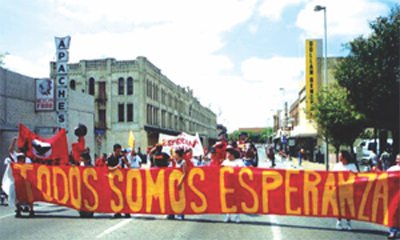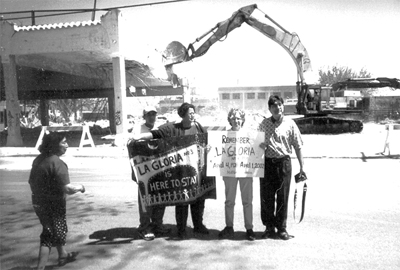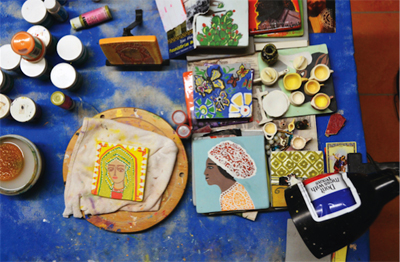Originally published in the San Antonio Current.
Imelda Arismendez sits on a ladder, molding adobe with her bare hands. Her long, brown braid hangs behind her as she sculpts details onto the front of her new home, or so it’s beginning to feel like. This building will house MujerArtes’ new studio — the Esperanza Peace and Justice Center’s clay cooperative — where Arismendez is the coordinator, teacher and a founding member. “It’s emotional, but we’re excited,” she says about the move from the current studio to the new one. “More than anything, it’s going to be a happy moment.”
If you’ve lived in San Antonio your whole life, there’s a good chance you’ve never seen an adobe building on any side of town. Once a popular material used in South Texas, adobe now serves as a symbol of Mexican heritage. Its foundation is made from natural ingredients like straw, water and cacti. Its walls are thick and protective, providing a shield of safety. And for the first time in over 100 years, adobe is being used for a new building in San Antonio to house MujerArtes’ new work space.
The women involved in the arts organization dedicate several hours of their time each week to crafting, sculpting and painting their work. They have full-time jobs, raise families and still make time for their art and the other mujeres of the cooperative. They’ve seen their new center go from an idea to a nearly finished structure, because they’ve been involved in the process every step of the way. From hand mixing the adobe to detailing the facade, this building belongs to them as much as it does to the Esperanza. Their ability to create together and work not just with each other but for each other is the foundation that the Esperanza Center was built on.
Celebrating its 30th anniversary this year, the Esperanza Center continues to push for social justice in San Antonio, continuously fighting for equal treatment of women, people of color, LGBTQ and working class members of the community. Through art, the Esperanza Center, its staff and volunteers have translated issues of race, political ideologies, socioeconomics, ethnicity and other forms of identity into a language that promotes interconnection. At its core, the Esperanza is a safe space for marginalized people, tirelessly campaigning for social change. San Antonio is now home to many civil rights organizations, like the Martinez Street Women’s Center and Fuerza Unida, that are strong, powerful leaders in the march for equality. It was the Esperanza that helped build the paths they walk on.
*****
A large white banner reading “San Antonio Women — Peace. Work. Equality” leads a group of marchers from City Hall through the streets of downtown. “Women Hold Up Half the Sky” is written on another sign that follows, held by two women who are chanting with the crowd. The video shows a band of marchers coming to a halt as they gather around a stage where a mic is shared between poets, musicians and activists.
A woman steps up to the podium and starts to speak about equality for mothers, for women in the workforce. It looks like it could be a scene from the massive Women’s March on Washington last month, except this is the mid ‘80s, the crowd is almost all brown women, and it’s the first International Women’s Day March ever held in San Antonio.
The group of women who organized the march included the Esperanza’s current director, Graciela Sánchez, and co-founder and initial director Susan Guerra. Inspired by the International Women’s Day March in Oslo, Norway, where Guerra was previously living, the women got to work. They billed union organizer and labor strike leader Emma Tenayuca as the keynote speaker and set a radical tone for the march, which the organization still carries today.
After the march, the women involved wanted a way to keep discussing civil rights issues in San Antonio.
“We all wondered, how can we continue to work together?” Sánchez says, describing the moment the nonprofit was conceived. Unlike other organizations at the time, the Esperanza wanted to step away from a single-issue mindset and build an institution that would be inclusive to all women. More importantly, the organization wanted to foster dialogue around intersectionality, a term first coined by civil rights advocate Kimberlé Williams Crenshaw to describe the overlapping of social identities (age, race, religion, gender, sexual orientation, etc.) and how these play into systems of oppression and discrimination.
“The name Esperanza,” Sánchez says, “means hope,” and with a wide smile she revisits a hot, sticky Texas summer day, where she and Guerra are sitting and dreaming of what they’d call their future safespace. By 1988, Sánchez had become director and a team of volunteers, or buena gente as they’re referred to, had been assembled. In fact, those volunteers are how the organization has been able to operate as long as it has.
For $1 a year, the Esperanza Center found its home in a building owned by the Oblate Fathers where they shared a space with the Central America Information Center, Latin American Assistance, the American Civil Liberties Union and Habitat for Humanity (needless to say, they were in good, like-minded company). However, six years after its inception, the Esperanza got an eviction notice after hosting a queer art show. It was clear to the Esperanza’s organizers that as long as there was a stigma against the queer community in San Antonio, they would be bounced from building to building, unable to plant roots.
So by that point, a permanent home base became necessary. The center was able to purchase its first building on San Pedro, which currently serves as Esperanza’s headquarters, exhibition area, meeting space, performance stage and storefront for the work created at MujerArtes. The building is nothing like your typical office. Guests are met with iron french doors, opening to a room with art on the walls that double as both a history and geography lesson, preserving the folk art styles of South and Central America. Turn to the left and you’ll find a room full of computers where the Esperanza’s staff are planning monthly programs, editing videos and preparing for future events. Prints and brightly colored paintings, including a large portrait of César Chávez, cover the blood-orange walls. Newspapers and books are stacked everywhere so that little desk space is visible. A print that reads “Fiesta is Racist” is tucked away next to a computer – it’s small, but somehow the loudest piece in the room.
The Esperanza Center uses its upstairs loft to hold movie screenings, performances, lectures and so on. Their programs, held monthly, annually and intermittently, cover a wide range of interests and volunteers meet here on a monthly basis to help cobble together and mail the Esperanza’s newsletter, La Voz — a catchall for anecdotes and updates on civil rights issues from across the globe and within the community.
Though regular volunteers and staff pass through the building on a daily basis, the organization has always made it a priority to ensure that visitors — whether they’re queer, trans, immigrant, Latina/o/x, black, Muslim, poor — feel comfortable and know that they have a home at the Esperanza. That inclusive, open-door policy hasn’t always sat well with others. It was in the late ‘90s that San Antonio City Council stripped funding away from the organization after the Esperanza organized an event that city leaders considered too controversial. Once again, the Esperanza was at the center of a debate over discrimination and questioning the people in power.
*****
Attorney Amy Kastely led a room full of volunteers and staff in a mock trial, during which she served as the judge asking questions and picking at the evidence in the case. The next day, Kastely served as lead counsel in a case that marked a turning point in the Esperanza’s history.
On September 11, 1997, city council voted to defund the organization after it co-sponsored “Out at the Movies,” a gay and lesbian film festival that the group held on city-owned property. In defunding the Esperanza, the newly elected council, led by Mayor Howard Peak, claimed it wanted to direct city money to cultural arts programs that helped boost tourism. City leaders also admitted they didn’t want to fund nonprofits that had what they considered to be a controversial message – and being brown and queer meant that the Esperanza Center didn’t fit the city’s new mold.
In the background, the push to defund the Esperanza was fueled by letters and phone calls from local religious and conservative groups. The Esperanza Center eventually filed a lawsuit against the city in which, three years later, a federal judge called the city’s actions unconstitutional. As Judge Orlando Garcia wrote in his ruling, “…Once a governing body chooses to fund art, however, the Constitution requires that it be funded in a viewpoint-neutral manner, that is without discriminating among recipients on the basis of their ideology.” The city agreed to pay out half a million dollars in monetary damages following Garcia’s ruling.
At first the Esperanza Center and its supporters weren’t even that sure they’d win the legal fight, but they used the lawsuit to build awareness. While coordinating their legal strategy, the Esperanza also launched two campaigns, Arte es Vida and Todos Somos Esperanza, to highlight the issue of government discrimination against queer people of color.
In her book, Activism, Alliance Building and the Esperanza Peace and Justice Center, UTSA communications professor Sara DeTurk says the nonprofit used the lawsuit to spark a larger conversation in the community and to build alliances with like-minded organizations. The public awareness campaign the Esperanza built around the defunding lawsuit, she writes, helped the organization share its “vision and struggles, develop strong relationships with various individuals and organizations, and contribute to the political growth of the community.”
The defunding battle proved the Esperanza was a force to be reckoned with, one that demanded respect and fair treatment and urged other cross-issue, multicultural groups around the city to demand the same. It also proved the Esperanza wouldn’t back down from a fight – particularly as the group started to focus on preserving and saving the city’s cultural heritage from the bulldozing march of “progress.”
*****
Gloria Ramirez ran up to an angry crowd of protesters with a check for $239,000 in hand. She was the last hope to save La Gloria, a historic building that belonged to the Westside.
Ramirez had the check in her right hand but was restrained by two police officers, each holding onto one arm. Backhoes stood ready to dismantle the structure. The building’s owner, Tony Limon, refused Ramirez’s check and the wrecking crew started their work. Some of the protesters in the crowd actually started to weep.
The 2002 demolition of La Gloria was a wakeup call for activists at the Esperanza. The gas station turned rooftop dance spot was the first Tejano venue in the country. La Gloria and all its history couldn’t be saved. Some felt trust between the city and residents of the Westside, a predominately Mexican-American side of town, had been disrupted. To the Esperanza, the demolition was a call to arms.
A drive around the Westside today shows how the Esperanza responded to the pain and anger over La Gloria’s razing. There’s the Esperanza’s largest preservation project, “En Aquellos Tiempos: Fotohistorias del Westside,” an outdoor photo exhibition that started in 2006. It began with 50 banners that show a collection of large-scale photographs that depict longtime residents of the area, telling the stories of the Westside from 1900 to the early 1950s. The project has since grown to over 150 full-blown images, coupled with anecdotes and historias. The idea behind the installation was to engage the neighborhood, get people to tell their own stories, and start documenting the area’s rich history. Key to the Esperanza’s preservation efforts are the Westside residents whose families have lived there for generations.
In December 2011, after a two-year battle, the Esperanza helped stop the demolition of Casa Maldonado, known to some as the Pink Building. Before it fell into disrepair, the building was home to union organizer William Maldonado, and neighbors recalled the Casa Maldonado being a hub for political activism and organizing on the Westside as early as the 1940s. The house now sits refurbished on the Guadalupe Street corridor.
A year later, the Esperanza Center purchased Lerma’s Nite Club, the oldest conjunto music venue in the country, which played host to musicians like Eva Ybarra, Santiago Jimenez and Lydia Mendoza in its heyday and is considered a conjunto music landmark. The Esperanza still owns the building, but with a projected cost of nearly $2 million for renovations, the building sits empty.
With money raised through community fundraising, the Esperanza now owns five buildings on the Westside, three (soon to be four) of which are located in the Rinconcito de Esperanza, or Corner of Hope. The front building, Casa de Cuentos, plays host to workshops year-round that revolve around Mexican culture, holiday traditions and is where the Esperanza hosts its monthly oral history gathering – a storytelling project that, as UTSA professor DeTurk puts it, “provokes social change through personal empowerment.” At each workshop and event, you’ll find someone — typically Sánchez — recording the whole thing from a corner of the room.
Two blocks away, inside a busy but welcoming yellow house, a group of women are working on a collection of painted tiles. One woman, the youngest one there, is nearly finished with a mosaic that will be placed on a wall inside the new MujerArtes building. The shelves inside the studio are full of painted ceramics. Bowls, sculptures and vases cover every inch of wall space. Directly in the center shelf is an arbol de vida — a traditional Mexican ceramic piece in the shape of a tree — that was crafted 20 years ago, around the time of the Esperanza’s 10th anniversary. The tiny mementos that sit on the branches act like time capsules, each one created by a different woman to represent something important in her life.
While the art made at MujerArtes might not be blatantly political, there’s no denying that politics is a function of their work. They use this space and its materials — clay, paint, sketchpads — to tackle issues of racism, sexism, sexual orientation and classism. They chat while they work and they ask each other for advice, using the group of women as a springboard for ideas. Their work mimics the traditions of Mexican folk art, but unlike the ceramics you see for sale downtown, it isn’t marketed for tourist consumption. Here, the art is made to build community.
*****
Back at the Esperanza’s headquarters, Gianna Rendon is giving a tour of the gallery space. She points to a banner on the wall with the organization’s name, and next to it are cutouts of little fabric houses with the words “a house of Hope.” There’s a dove situated at the top of the banner. Rendon says it was the first banner to hang at the Esperanza Center 30 years ago and was brought to their permanent home during the move.
Rendon is the outreach and intern coordinator at the Esperanza. She’s 23, working on a master’s degree and got her start with the organization as a volunteer, eventually moving up to intern and landing a full-time position two years ago. She and the staff members and buena gente her age are likely the future of the organization, and the legacy of the Esperanza will eventually carry on through these young activists.
With the adobe studio nearly finished and plans for their 2017 programming in the works, the Esperanza Center remains a catalyst of upward mobility for the working class, the brown folks, the transgender teens, the immigrants who flee their countries, and anyone in need of a home. For Esperanza, it’s not about being the voice of a community. Rather, it’s about creating a space where a community can have a voice for itself. “You don’t always get to be the poet or the activist,” Sánchez says, “it’s about teaching people that they can be that for themselves.”








